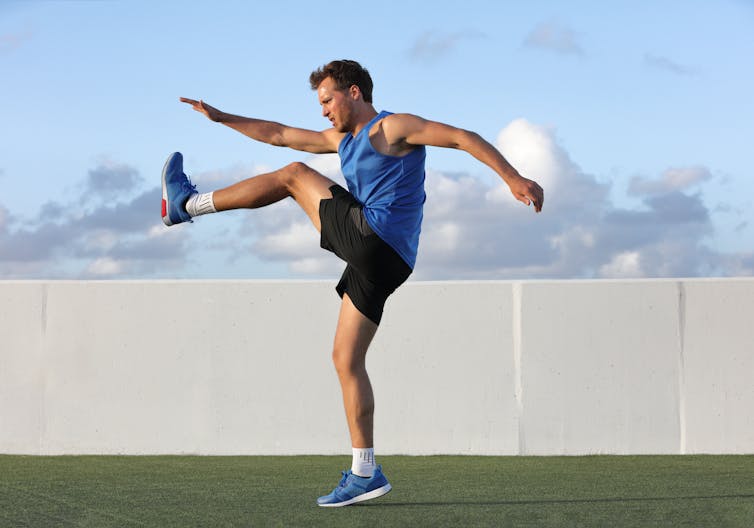Many of us see stretching as an crucial a part of any workout or exercise regime. It is helping us build up our flexibility and our vary of motion. Many people additionally stretch to calm down earlier than exercising, and to assist recuperate once we’re completed.
Despite the fact that stretching has lengthy been a mainstay of just about each and every exercise regimen, does it have as a lot of an impact on efficiency and restoration as we imagine?
The rationale we really feel extra versatile after stretching is as a result of an build up within the degree of discomfort we’re ready to endure on the extremes of our vary of motion. That is referred to as stretch tolerance.
It used to be lengthy thought to be that static stretching – preserving a limb on the fringe of its vary of motion, generally for as much as a minute – used to be a requirement for any first rate warm-up. It used to be concept that pushing this vary of motion would briefly build up flexibility, in principle serving to to stop accidents and beef up efficiency all through workout.
Across the finish of the closing century, then again, proof emerged that static stretching may just in fact have unwanted side effects on energy, energy and velocity. It’s extensively been agreed since that static stretching will have to be have shyed away from all through a warm-up.
Dynamic stretching has as a substitute transform extra widespread all through warm-ups. Dynamic stretching comes to intentionally shifting a limb time and again via its whole vary of motion.
Dynamic stretching doesn’t hinder efficiency the way in which static stretching does. In reality, it is going to even build up muscle energy whilst nonetheless offering the momentary will increase in flexibility introduced via static stretching. Sooner than doing any form of workout, a little of dynamic stretching is advisable.
It’s value noting that static stretching does nonetheless build up vary of motion. And any detrimental unintended effects will even be have shyed away from if carried out correctly. However static stretching a unmarried muscle staff for greater than 90 seconds considerably will increase the possibility of worsened efficiency. Any static stretches carried out earlier than a exercise will have to be transient.

Maridav/ Shutterstock
The reverse appears to be true for dynamic stretching. It seems that that acting dynamic stretching for not up to 90 seconds is a long way much less prone to beef up flexibility and function than longer bouts. When dynamic stretching, give every muscle staff consideration and take your time.
After workout
Many of us additionally love to stretch after exercising, generally with the purpose of lowering muscle soreness and harm chance.
Not on time-onset muscle soreness is not unusual, and generally follows workout you’re no longer used to, or that’s specifically exhausting. The feeling of soreness is generally intensified when the muscle in query is lengthened. This tells us that the muscle tissue’ in-built “stretch detectors” – known as muscle spindles – are curious about generating that feature painful sensation. The nerve pathways connected to muscle spindles are carefully associated with neural ache pathways. This reaction would possibly have advanced to permit muscle tissue the time to recuperate.
Stretching to stop muscle soreness has lengthy been advocated. However proof means that stretching simply earlier than and/or simply after workout in fact has no impact on muscle soreness all through the next days. So stretching to check out and keep away from the inevitable painful follow-up to a heavy exercise is nearly in no way going to get you any place. There could also be recently no compelling proof that stretching can assist scale back accidents in actions with prime harm charges.
Past static and dynamic stretching, different ways have grown in reputation in recent times.
Ballistic stretching is very similar to dynamic stretching, however contains bouncing actions to push the variability of motion to the very extremes of its limits. Any other form of stretching, known as proprioceptive neuromuscular facilitation, or PNF, comes to repeated contraction and leisure of the objective muscle tissue so as so they can stretch. Many imagine PNF allows a better vary of motion, however this impact simplest lasts for round 5 seconds after the top of the stretch.
All of those stretching strategies will build up flexibility, however according to present proof, static stretching remains to be simpler than both PNF or ballistic stretching at bettering vary of motion, and will even be quite higher than dynamic stretching.
However there’s truly no wish to over-complicate your stretching regimen. Paintings the huge muscle teams inside their levels of motion, and time issues correctly so your stretches don’t detract from the remainder of your workout. Whilst stretching by itself is not likely to have a lot have an effect on in your exercise or restoration, a little of stretching all through your warm-up might assist to steadily get ready your frame for workout.
That being mentioned, stretching for the sake of bettering flexibility nonetheless supplies a large number of well being advantages, together with advanced stream and decreased blood drive. Public tips counsel doing flexibility workout routines two or thrice per week, incorporating each static and dynamic stretches.
If hammering out the ones stretches in an instant after a exercise is probably the most sensible time to include your flexibility coaching, it indubitably isn’t going to do you any hurt. And in case you are nervous about accidents, your excellent wager is to concentrate on an intensive warm-up, which might smartly come with a hearty dose of dynamic stretching, too.
Supply Through https://theconversation.com/stretching-expert-explains-how-best-to-do-it-before-and-after-a-workout-137962



